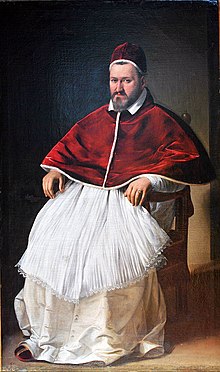
Back Pous Paulus V Afrikaans بولس الخامس Arabic بولس الخامس ARZ Pablu V AST Павел V Byelorussian Павал V BE-X-OLD Павел V Bulgarian Paol V Breton Pau V Catalan Gáu-huòng Paulus 5-sié CDO
Paul V | |
|---|---|
| Bishop of Rome | |
 | |
| Church | Catholic Church |
| Papacy began | 16 May 1605 |
| Papacy ended | 28 January 1621 |
| Predecessor | Leo XI |
| Successor | Gregory XV |
| Orders | |
| Ordination | 20 October 1577 |
| Consecration | 27 May 1597 by Clement VIII |
| Created cardinal | 5 June 1596 by Clement VIII |
| Personal details | |
| Born | Camillo Borghese 17 September 1550 |
| Died | 28 January 1621 (aged 70) Rome, Papal States |
| Previous post(s) |
|
| Motto | Absit nisi in te gloriari (Far, but in your glory)[1] |
| Coat of arms |  |
| Other popes named Paul | |
Pope Paul V (Latin: Paulus V; Italian: Paolo V) (17 September 1550 – 28 January 1621), born Camillo Borghese, was head of the Catholic Church and ruler of the Papal States from 16 May 1605 to his death, in January 1621. In 1611, he honored Galileo Galilei as a member of the papal Accademia dei Lincei and supported his discoveries.[2] In 1616, Pope Paul V instructed Cardinal Robert Bellarmine to inform Galileo that the Copernican theory could not be taught as fact, but Bellarmine's certificate allowed Galileo to continue his studies in search for evidence and use the geocentric model as a theoretical device. That same year Paul V assured Galileo that he was safe from persecution so long as he, the Pope, should live. Bellarmine's certificate was used by Galileo for his defense at the trial of 1633.[3]
Trained in jurisprudence, Borghese was made Cardinal-Priest of Sant'Eusebio and the Cardinal Vicar of Rome by Pope Clement VIII. He was elected as Pope in 1605, following the death of Pope Leo XI. Pope Paul V was known for being stern and unyielding, defending the privileges of the Church. He met with Galileo Galilei in 1616 and was involved in the controversy over heliocentrism. He canonized and beatified several individuals during his papacy and created 60 cardinals in ten consistories.
His insistence on ecclesiastical jurisdiction led to conflicts with secular governments, notably with Venice, which resulted in an interdict on the city in 1606. This disagreement was eventually mediated by France and Spain in 1607. Pope Paul V's diplomacy also strained relations with England, as his actions were perceived as undermining moderate Catholics in the country.
In Rome, he financed the completion of St. Peter's Basilica, improved the Vatican Library, and restored the ancient Roman aqueduct Aqua Traiana. Pope Paul V established the Banco di Santo Spirito in 1605 and is also known for fostering the rise of the Borghese family through nepotism. He died on 28 January 1621, after suffering from a series of strokes and was succeeded by Pope Gregory XV.
- ^ "Pope Alexander VII (1655–1667)". GCatholic. Retrieved 10 May 2014.
- ^ MacLachlan, James (15 April 1999). Galileo Galilei: First Physicist. Oxford University Press, USA. p. 59. ISBN 9780195131703.
- ^ Blackwell, Richard J. (31 January 1991). Galileo, Bellarmine, and the Bible. University of Notre Dame Pess. p. 124. ISBN 9780268158934.
© MMXXIII Rich X Search. We shall prevail. All rights reserved. Rich X Search